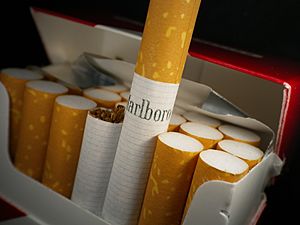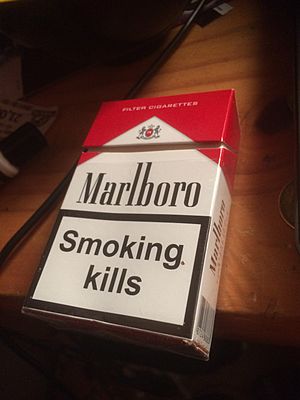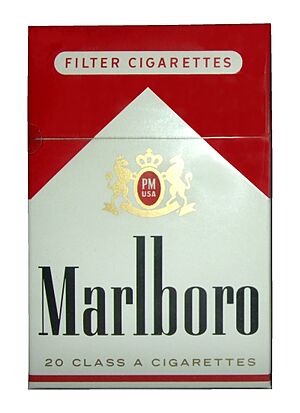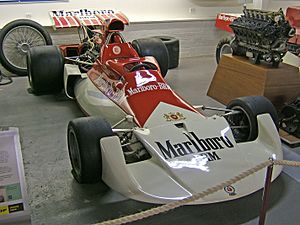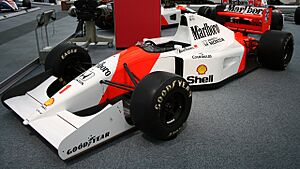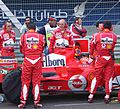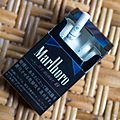Marlboro facts for kids
 |
|
| Owner |
|
|---|---|
| Country | United States |
| Introduced | 1924 |
| Tagline | "Mild As May", "Come to where the flavor is. Come to Marlboro country" (1966), "You get a lot to like with a Marlboro", "You Decide", "Pursue Flavor" |
Marlboro is an American brand of cigarettes. In the United States, it is made by a company called Philip Morris USA. Outside of the U.S., it is made by Philip Morris International. The brand was first sold in 1924.
Originally, Marlboro cigarettes were marketed to women. But in the 1950s, the company changed its advertising to appeal to men. This new campaign featured a character known as the Marlboro Man, a rugged cowboy. This made Marlboro one of the most famous and best-selling cigarette brands in the world.
Today, Marlboro is still a major brand. Its largest factory is in Richmond, Virginia. In some countries, like Canada and India, different companies own and make products with the Marlboro name.
Contents
History
The story of Marlboro starts with a British tobacconist named Philip Morris. He opened a shop in London in 1847. After he passed away, his family continued the business. They opened a factory on Great Marlborough Street, which is where the name "Marlboro" comes from.
In 1902, the company opened an office in New York. The Marlboro brand was officially launched in 1924. At first, they were sold as a luxury item in fancy hotels and resorts.
A Change in Marketing
In the 1930s, Marlboro was advertised as a cigarette for women with the slogan "Mild As May." However, sales were very low.
During the 1950s, scientists published studies that linked smoking to serious health problems like lung cancer. This made many people worried about smoking. At the time, filtered cigarettes were seen as being for women. Philip Morris saw a chance to sell filtered cigarettes to men who were concerned about their health but also wanted to appear masculine.
The company hired an advertising agency to create a new image for the brand. They came up with the idea of using strong, manly figures in their ads, like sea captains and athletes. The most successful of these was the cowboy, who became known as the Marlboro Man. This new advertising campaign was a huge success.
To make their cigarettes seem milder, the company began adding chemicals like ammonia to the tobacco. This also made the nicotine deliver more effectively.
By 1972, Marlboro had become the best-selling tobacco brand in the world.
Modern Changes

In 2006, a U.S. court ruled that cigarette companies could no longer use words like "Lights" or "Mild." The court said these words could trick people into thinking some cigarettes were safer than others. Because of this, companies started using colors to name their products. For example, Marlboro Lights became Marlboro Gold Pack.
In recent years, the packaging has also changed. In 2013, a new design called "Marlboro 2.0" was introduced in Europe and other regions. Many countries now require large health warnings on cigarette packs, so the classic design is less common.
Advertising
In the 1920s, Marlboro ads focused on women. The filter even had a red band around it to hide lipstick stains. It was called a "Beauty Tip."
The famous red and white package was created by designer Frank Gianninoto. The shift to marketing to men was led by advertiser Leo Burnett. His idea of using a series of "manly figures" was very successful. The cowboy character was so popular that the company decided to use only him in their ads.
The Marlboro Man campaign helped the brand's sales grow from less than 1% of the market to the fourth best-selling brand. The TV ads for the campaign, which ran from 1963, used music from the movie The Magnificent Seven.
Over the years, Philip Morris used the Marlboro brand in many magazine ads, posters, and billboards. They also sold items like lighters and sunglasses with the Marlboro logo.
Sport Sponsorship
Marlboro was famous for sponsoring motor racing teams. The company believed that the exciting and heroic image of racing fit well with the "Marlboro Man" image.
Formula One
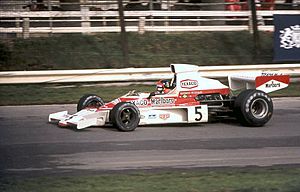
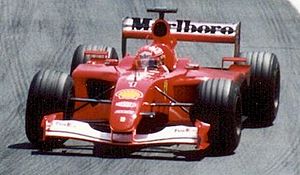
Marlboro's involvement in Formula One (F1) began in 1972 with the BRM team. In 1974, they started a long and successful partnership with the McLaren team. With Marlboro's sponsorship, McLaren won several world championships with famous drivers like Niki Lauda, Alain Prost, and Ayrton Senna. This partnership lasted for 23 years, until 1996.
Marlboro also began sponsoring the Scuderia Ferrari team in the 1990s, and it became the team's main sponsor in 1997. The team was even officially named "Scuderia Ferrari Marlboro." This partnership continued for many years, making the red Ferrari cars with white Marlboro logos an iconic sight in F1.
Over time, many countries banned tobacco advertising. To follow these laws, the teams had to get creative. They would replace the Marlboro logo with a special chevron symbol, a barcode design, or simply the name of the team or driver.
Even after direct advertising was banned, Philip Morris continued to sponsor Ferrari. The team used a barcode design that some people felt was a subliminal, or hidden, way of advertising the brand. This caused some controversy, and the barcode was eventually removed from the cars.
Other Racing Series
Marlboro also sponsored teams and drivers in many other types of racing, including:
- Grand Prix motorcycle racing: The brand sponsored the Yamaha team in the 1980s and 1990s, and later the Ducati team.
- IndyCar: For 20 years, Marlboro sponsored Penske Racing, one of the most successful teams in American auto racing.
- World Rally Championship: Marlboro sponsored factory teams from Lancia, Mitsubishi, and Peugeot.
Marlboro in Canada
In 1932, Philip Morris sold the Canadian rights to the "Marlboro" name to another company, Imperial Tobacco Canada. This means that the Marlboro cigarettes sold in Canada are a different product from the ones sold in the rest of the world.
Philip Morris has tried to get the Canadian rights back but has not been successful. For a while, they sold their international version in Canada without a brand name, using only the famous "rooftop" logo. However, a Canadian court ruled that this was confusing for customers. Now, Philip Morris sells these cigarettes in Canada under the brand name "Rooftop."
Morley: A Fictional Brand
Morley is a fictional brand of cigarettes that often appears in movies and TV shows. Its packaging looks very similar to the Marlboro pack. The name "Morley" is a play on "Marleys," a common nickname for Marlboro.
Morleys have been used in productions since at least 1960, when they appeared in the Alfred Hitchcock film Psycho. They are famously smoked by the Cigarette Smoking Man, a character in the TV series The X-Files.
Production companies use fictional brands like Morley to avoid showing real brands on screen, especially if they don't have a sponsorship deal. The Morley props are sold by a special company in Hollywood that makes fake packaging for movies.
Images for kids
See also
 In Spanish: Marlboro para niños
In Spanish: Marlboro para niños
- Health effects of tobacco


